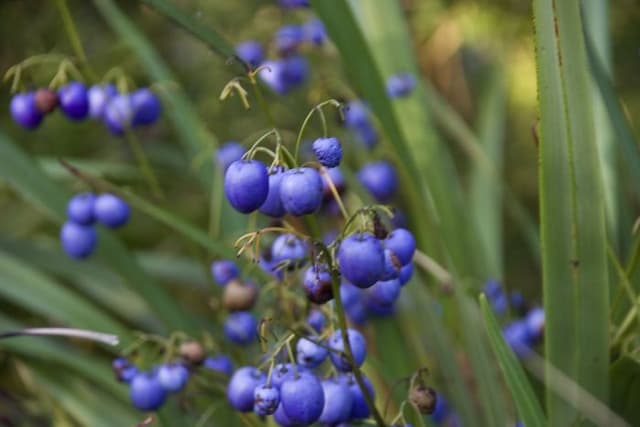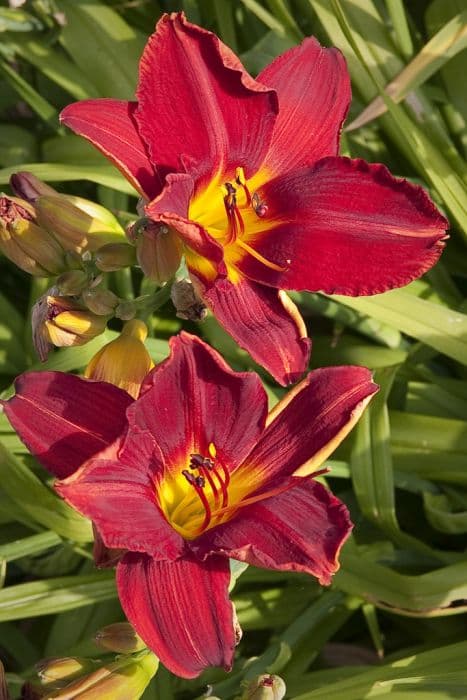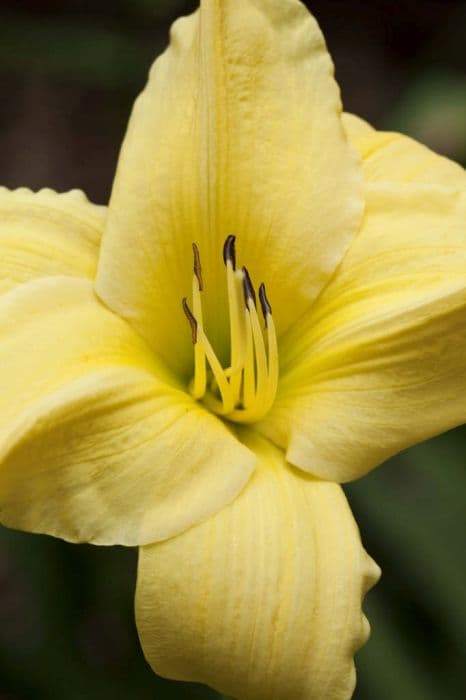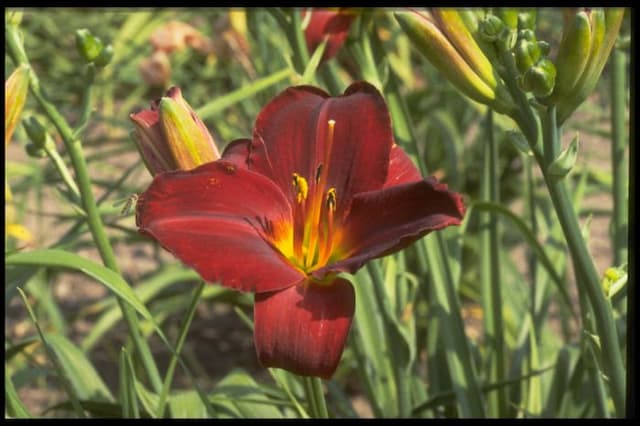Daylily Hemerocallis 'Red Precious'

ABOUT
Hemerocallis 'Red Precious', commonly known as the Daylily 'Red Precious', features a vibrant display of rich, crimson-red flowers. Each bloom is characterized by a striking contrast, with a lighter throat that can be yellow or green-tinted, drawing attention to its center. These trumpet-shaped flowers typically have ruffled edges, which add a touch of elegance and texture. The blossoms sit atop erect, slender stems which emerge from a dense clump of foliage. The leaves are long, arching and grass-like, presenting a lush green backdrop that sets off the red blooms quite vividly. The Daylily 'Red Precious' is a perennial favorite in gardens for its showy and colorful presence, creating a bold statement wherever it is planted.
About this plant
 Names
NamesSynonyms
Daylily
Common names
Hemerocallis fulva 'Red Precious', Hemerocallis 'Red Precious'.
 Toxicity
ToxicityTo humans
Daylily 'Red Precious' is not considered highly toxic to humans. In fact, certain parts of the daylilies, such as the flowers, are edible when prepared correctly. However, as with any non-cultivated plant, ingestion might cause individual allergic reactions or digestive irritation in some people. It's always a good idea to be cautious and not consume plant parts unless you are certain of their safety and have identified them correctly. If a person were to experience symptoms after eating any parts of the plant, they should seek medical attention, but significant toxicity is not commonly reported with daylilies and their cultivars in humans.
To pets
Daylily 'Red Precious' is toxic to certain pets, especially cats. Daylilies are known to be highly toxic to cats and can cause acute kidney failure. Symptoms of daylily poisoning in pets may include vomiting, lethargy, kidney failure, or lack of appetite. If a cat ingests any part of a daylily, it should be considered a medical emergency, and the pet should be taken to a veterinarian immediately. Other pets such as dogs may experience mild gastrointestinal upset if they consume daylilies, but the risk is especially high and severe for cats.
 Characteristics
CharacteristicsLife cycle
Perennials
Foliage type
Deciduous
Color of leaves
Green
Flower color
Red
Height
2 feet (60 cm)
Spread
2 feet (60 cm)
Plant type
Herb
Hardiness zones
3
Native area
Asia
Benefits
 General Benefits
General Benefits- Attracts Pollinators: Hemerocallis 'Red Precious', also known as Daylily, draws in bees and butterflies, contributing to the ecosystem's pollination process.
- Low Maintenance: Daylilies are known for their hardiness and require minimal care, making them suitable for busy or novice gardeners.
- Drought Tolerance: Once established, Daylilies can withstand periods of low water availability.
- Versatility in Landscaping: Suitable for borders, beds, and as ground cover, Daylilies are versatile in gardening design.
- Colorful Blooms: Produces vibrant red flowers that enhance the aesthetic appeal of any garden.
- Fast Growth: Daylilies grow quickly, filling up garden spaces and providing fast results for landscapers.
- Pest Resistance: These plants are not often bothered by pests, reducing the need for chemical treatments.
- Soil Stabilization: Their root systems can help prevent erosion by stabilizing the soil.
- Long Bloom Season: Daylilies have a lengthy flowering period compared to many other garden plants.
- Edible Parts: Some parts of the Daylily are edible and can be used in culinary applications, although this use is not widely recognized or embraced.
 Medical Properties
Medical PropertiesThis plant is not used for medical purposes.
 Air-purifying Qualities
Air-purifying QualitiesThis plant is not specifically known for air purifying qualities.
 Other Uses
Other Uses- The daylily's tuberous roots can be used in plant propagation through division, helping gardeners to expand their collection or share with others.
- The flowers can serve as a natural dye for fabrics, offering shades ranging from yellows to pinks depending on the part of the flower used.
- Daylilies are sometimes used in companion planting to attract pollinators like bees and butterflies to the garden, which benefits other plants nearby.
- Edible varieties like the daylily can be used in floral cuisine to add a touch of color and mild flavor to salads and desserts.
- The thick foliage of the daylily can provide ground cover, suppressing weeds, and reducing the need for mulching or other ground maintenance.
- When planted on slopes or banks, the robust root system of the daylily can help with erosion control, holding soil in place during heavy rains.
- In water garden designs, daylilies can be planted along the edges of ponds or streams to add a burst of color while providing a naturalized look.
- As a natural pest deterrent, daylilies can help to protect nearby plants from being eaten by certain herbivores due to their slightly toxic nature.
- Some daylilies are used in art and photography for their striking colors and symmetrical shapes, often serving as subjects in botanical art.
- The spent blooms of daylilies can be added to compost piles where they will break down and contribute to the creation of nutrient-rich compost.
Interesting Facts
 Feng Shui
Feng ShuiThe Daylily is not used in Feng Shui practice.
 Zodiac Sign Compitability
Zodiac Sign CompitabilityThe Daylily is not used in astrology practice.
 Plant Symbolism
Plant Symbolism- Transience: 'Hemerocallis' comes from the Greek words 'hemera' meaning day and 'kallos' meaning beauty, signifying the fleeting beauty of its flowers since each flower typically lasts only a day.
- Survival and Perseverance: Daylilies, known for their ability to thrive with minimal care, are often associated with enduring hard conditions and flourishing in less than ideal circumstances.
- Passion and Emotion: The vibrant 'Red Precious' daylily can symbolize intense emotions and passionate feelings, which its bold red color represents.
- Motherhood: In Chinese culture, daylilies are associated with motherhood and the devotion of mothers due to their prolific nature and nurturing appearance.
 Water
WaterDaylilies, like Hemerocallis 'Red Precious', prefer to be watered deeply and thoroughly. This means you should water them in a way that the moisture reaches deep into the soil, promoting healthy root growth. It's generally best to water daylilies once a week with about 1 inch of water, which equates to approximately 0.6 gallons per square yard. During hot or dry periods, you might need to water more frequently to maintain consistent soil moisture. Always check the soil before watering; if the first few inches of soil are dry, it's time to water.
 Light
LightDaylilies thrive in full sun to partial shade, with at least six hours of sunlight a day being ideal for Hemerocallis 'Red Precious'. The best spot for this plant is one where it will receive morning sun and afternoon shade, especially in regions with very hot summers. Avoid deep shade as this can reduce the vigor and number of blooms.
 Temperature
TemperatureDaylilies are hardy and can tolerate a wide range of temperatures, but Hemerocallis 'Red Precious' performs best when daytime temperatures are in the range of 60°F to 75°F. They can survive minimum winter temperatures down to -20°F and maximum summer temperatures as high as 90°F. However, for optimal growth and flowering, maintaining average temperatures within the ideal range is recommended.
 Pruning
PruningPruning daylilies consists mainly of deadheading spent flowers and removing dead foliage. For Hemerocallis 'Red Precious', remove spent flower stalks at their base after blooming to encourage reblooming and to keep the plant looking tidy. Cut back the foliage to the ground in late fall to prepare the plant for winter and to help prevent disease. Pruning can be done whenever there is dead or yellowing foliage, generally after the blooming period.
 Cleaning
CleaningAs needed
 Soil
SoilDaylilies (Hemerocallis 'Red Precious') thrive in well-draining soil with a slightly acidic to neutral pH, ranging from 6 to 7. A good soil mix includes equal parts garden soil, compost, and perlite or sand to ensure proper drainage.
 Repotting
RepottingDaylilies should be repotted or divided every 3 to 4 years to rejuvenate the plant and encourage blooming. The best time for repotting is early spring or after the blooming period.
 Humidity & Misting
Humidity & MistingDaylilies prefer moderate humidity levels but are quite adaptable and do not require any special humidity adjustments in typical garden environments.
 Suitable locations
Suitable locationsIndoor
Place daylilies in bright, indirect light indoors; ensure good air circulation.
Outdoor
Plant daylilies in sunny to partially shaded spots, ensure soil drains well.
Hardiness zone
3-9 USDA
 Life cycle
Life cycleThe daylily 'Red Precious' begins its life as a dormant bare root or rhizome that, when planted in well-draining soil and exposed to sufficient sunlight, erupts into growth during the spring. As the weather warms, grass-like foliage emerges, followed by the development of sturdy scapes that will bear the vibrant red flowers for which it is named. Throughout the summer, these trumpet-shaped blossoms open for just one day each, a trait characteristic of daylilies, after which they wither to be replaced by new blooms in the cycle. After the flowering season, the plant redirects energy into bolstering the root system and storing nutrients for dormancy in winter. During the cold season, the foliage dies back, and the plant rests until the warmth prompts the next cycle of growth and blooming. With each passing year, the 'Red Precious' daylily can expand in clump size, necessitating division every few years to maintain vigor and ensure optimal flowering.
 Propogation
PropogationPropogation time
Early Spring to Summer
Hemerocallis 'Red Precious', commonly known as the Daylily, is generally propagated through division, a process best performed in early spring or late summer after the flowering period has finished. To propagate by division, carefully dig up the plant, ensuring that you keep a generous amount of soil around the roots. Gently separate the clumps into smaller sections, each with several fans of leaves and a portion of the root system intact. You should aim for divisions that are roughly equivalent to a quart in volume (~950 ml). Replant the divisions immediately, maintaining the same soil level as before, and water them thoroughly to help establish them in their new locations. This method is favored for its simplicity and the rapid increase of plants it allows.









